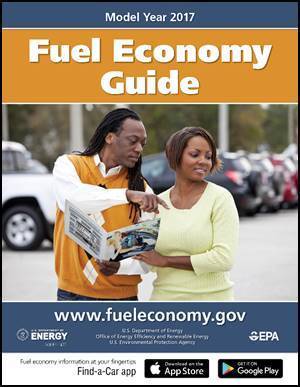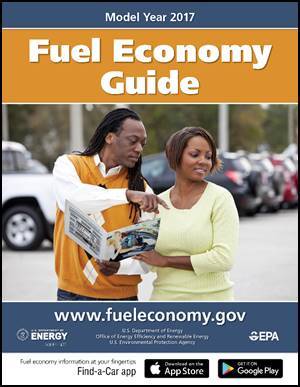2017 Fuel Economy Guide Now Available on Fueleconomy.gov
 |
An electronic version of the 2017 Fuel Economy Guide is now available online at fueleconomy.gov (http://www.fueleconomy.gov/feg/printGuides.shtml). The U.S. Department of Energy (DOE) and the U.S. Environmental Protection Agency (EPA) publish and distribute the Guide each year to help new car buyers choose the most fuel-efficient vehicle that meets their needs. The online version of the Guide will be updated weekly on fueleconomy.gov as additional information is submitted by the auto manufacturers. New and used car buyers can also use the Find-a-Car feature on fueleconomy.gov (http://www.fueleconomy.gov/feg/findacar.shtml) to compare the fuel economy of all vehicles sold in the United States since 1985.
Along with the Guide, DOE and EPA have released online versions of the 2017 "Top Ten" (http://www.fueleconomy.gov/feg/topten.jsp) and "Best and Worst in EPA Size Class" (http://www.fueleconomy.gov/feg/best-worst.shtml) fuel economy lists. Like the online Guide, these online lists will be updated throughout 2017 as new data become available.
The 2017 Top Ten fuel economy list is headed by the most fuel-efficient vehicle ever listed on fueleconomy.gov: the Hyundai Ioniq Electric, an all-electric vehicle (EV) that gets a combined 136 miles per gallon equivalent (MPGe) (where 33.7 kilowatt-hours equals 1 gallon of gasoline). Nine of the top ten vehicles for 2017 are EVs, and the other one is a plug-in hybrid electric vehicle (PHEV).
Excluding EVs, the most fuel-efficient vehicle in 2017 is a PHEV, the BMW i3 REX, which gets a combined 88 MPGe. On the non-EV Top Ten list, six of the vehicles are PHEVs and four are hybrid electric vehicles (HEV). Excluding both EVs and PHEVs, the Top Ten fuel economy list is all HEVs, the most fuel-efficient being the Toyota Prius Eco with a combined rating of 56 miles per gallon (MPG).
As for "Best in EPA Size Class" fuel economy, the winner among Two-Seaters is the smart fortwo cabriolet (35 MPG). Among Minicompacts, the top performer is an EV, the Fiat 500e (112 MPGe). The top Minicompact excluding EVs is the Fiat 500 (34 MPG).
The fuel economy winner among Subcompacts is an EV, the BMW i3 BEV (124 MPGe). The top Subcompact excluding EVs is the Toyota Yaris iA (35 MPG). The top Compact is an EV, the Chevrolet Volt (77 MPGe), while the top Compact excluding EVs is an HEV, the Lexus CT 200h (42 MPG).
The leader in the Midsize class is also the all-time leader among all classes, the Hyundai Ioniq Electric (136 MPGe). The top Midsize excluding EVs is an HEV, the Toyota Prius Eco (56 MPG). The top car in the Large class is the Honda Civic 5Dr (34 MPG).
The fuel economy leader among Small Station Wagons is an EV, the Chevrolet Bolt (119 MPGe). The top Small Station Wagon excluding EVs is the Honda Fit (36 MPG). The top Midsize Station Wagon is an HEV, the Toyota Prius v (41 MPG).
For Small Pickup Trucks, the fuel economy winner is the Chevrolet Colorado/GMC Canyon 2WD (25 MPG). Among Standard Pickup Trucks, the leader is the Ford F-150 2WD (22 MPG).
The fuel economy leader among Small SUVs is an HEV, the Toyota RAV4 Hybrid AWD (32 MPG). There's a tie for top Standard SUV between a PHEV (Volvo XC90 AWD PHEV at 30 MPGe) and an HEV (Lexus RX 450h AWD at 30 MPG).
Among Minivans, there's a tie at 22 MPG between the Chrysler Pacifica and the Toyota Sienna 2WD.
Again, these online "Top Ten" (http://www.fueleconomy.gov/feg/topten.jsp) and "Best and Worst" (http://www.fueleconomy.gov/feg/best-worst.shtml) lists will change throughout 2017 as new data become available, so please check back with fueleconomy.gov for the latest updates.
 |


